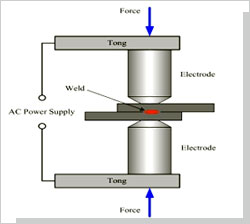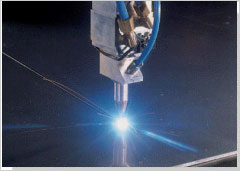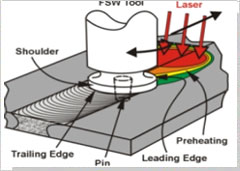 Welding is a fabrication process, which is used to join materials, especially metals or thermoplastics, by causing coalescence. This is generally done by melting the workpieces and adding a filler material to create a pool of molten material (the weld puddle), which cools to become a strong joint, with pressure sometimes used in alignment with heat, or by itself, to develop the weld. This is in contrast with soldering and brazing that involves melting a material (of low melting point) between the workpieces to produce a bond between them, without melting the workpieces.
Welding is a fabrication process, which is used to join materials, especially metals or thermoplastics, by causing coalescence. This is generally done by melting the workpieces and adding a filler material to create a pool of molten material (the weld puddle), which cools to become a strong joint, with pressure sometimes used in alignment with heat, or by itself, to develop the weld. This is in contrast with soldering and brazing that involves melting a material (of low melting point) between the workpieces to produce a bond between them, without melting the workpieces.
Although a practical skill, welding is also a great fun. The number of welded items that we see in our everyday lives is practically countless - the superstructure of the building in which we work, the bridges over which we drive, the spot welds on the bodies of our automobile, and the welded railings on our front steps. Welding, however, also makes possible, smaller, more delicate functional and decorative items, such as patio chairs and trellises, wine racks and candle holders.
Different energy sources can be used for welding, which include an electric arc, gas flame, an electron beam, a laser, friction, and ultrasound. While usually an industrial process, metal welding can be done in several different environments, including open air, underwater and in space. Regardless of location, however, welding is a dangerous process, and precautions should be taken to avoid electric shock, burns, poisonous fumes, and overexposure to ultraviolet light.
Welding ProcessesWelding Processes
- Arc Welding
- Gas Welding
- Resistance Welding
- Energy Beam Welding
- Solid State Welding
These different welding processes are described in brief below -
Arc WeldingIt is a welding process that uses a welding power supply to produce and maintain an electric arc between an electrode and a base material to melt metals at the welding point. It can be done through either alternating (AC) or direct (DC) current, and consumable or non-consumable electrodes, depending upon the material to be welded and the electrode used. The welding area is sometimes protected by some sort of inert or semi-inert gas, referred as a shielding gas, and filler materials are sometimes used as well.
The different forms of arc welding are -
- Electroslag welding
- Fluxed core arc-welding
- Gas metal-arc welding
- Plasma arc welding
- Shielded metal arc welding
- Submerged arc welding
- Gas tungsten arc welding
Gas Welding
Also known as oxyacetylene welding, it is one of oldest and most versatile welding methods, however in recent years, it has become less popular in industrial applications. The process is still frequently used for welding of pipes, tubes and repair works.
The equipment for gas welding are comparatively simple and economical, usually employing the combustion of acetylene in oxygen to create a welding flame temperature of about 3100 °C. The flame, being less concentrated than an electric arc, induces slower weld cooling that can result in greater residual stresses and weld distortion, although it eases the welding of high alloy steels. A similar method, usually called oxyfuel cutting, is used for metal cutting. Some other gas welding processes, such as oxygen hydrogen welding, air acetylene welding, and pressure gas welding are quite similar, usually differing only in the type of gases used. Gas welding is also used in plastic welding, however, in this case, the heated substance is air, and the temperatures are much lower.
Resistance Welding It is a welding process that involves the generation of heat by passing current through the resistance induced by the contact between the surfaces of two or more metals. Small pools of molten metal are made at the weld area as high current passes through the metal. In practice, resistance welding processes are efficient and create little pollution, however their applications are slightly limited and the equipment cost can be high.
It is a welding process that involves the generation of heat by passing current through the resistance induced by the contact between the surfaces of two or more metals. Small pools of molten metal are made at the weld area as high current passes through the metal. In practice, resistance welding processes are efficient and create little pollution, however their applications are slightly limited and the equipment cost can be high.
Some of the resistance welding methods include -
- Spot welding
- Seam welding
- Flash welding
- Projection welding
- Upset welding
Energy beam welding
 A relatively new process, energy beam welding methods include laser beam welding and electron beam welding. The process has become highly popular in high production applications. The two techniques of laser and electron beam are somewhat similar, differing primarily in their source of power. Laser beam welding utilizes a highly focused laser beam, while electron beam welding is executed in vacuum and utilizes an electron beam. Both these methods have very high energy density that makes deep weld penetration possible and minimizes the size of the weld area. Both of these methods are extremely fast, and are easily automated, which makes them highly productive.
A relatively new process, energy beam welding methods include laser beam welding and electron beam welding. The process has become highly popular in high production applications. The two techniques of laser and electron beam are somewhat similar, differing primarily in their source of power. Laser beam welding utilizes a highly focused laser beam, while electron beam welding is executed in vacuum and utilizes an electron beam. Both these methods have very high energy density that makes deep weld penetration possible and minimizes the size of the weld area. Both of these methods are extremely fast, and are easily automated, which makes them highly productive.
The major disadvantages of this method are their high equipment costs and a susceptibility to thermal cracking. Developments in this area include laser-hybrid welding that utilizes principles from both the laser beam welding as well as arc welding for even better welding results.
Solid-state welding Like the earliest welding process, forge welding, some of the modern welding processes do not require the melting of the materials being joined. One of the most preferred, ultrasonic welding, is used to connect thin sheets or wires made of metal or thermoplastic by vibrating them under high pressure and at high frequency. The equipment and processes involved are similar to that of resistance welding, in this case, however, vibration provides energy output instead of electric current. The process does not involve melting the materials; instead, the weld is produced by introducing mechanical vibrations horizontally under pressure.
Like the earliest welding process, forge welding, some of the modern welding processes do not require the melting of the materials being joined. One of the most preferred, ultrasonic welding, is used to connect thin sheets or wires made of metal or thermoplastic by vibrating them under high pressure and at high frequency. The equipment and processes involved are similar to that of resistance welding, in this case, however, vibration provides energy output instead of electric current. The process does not involve melting the materials; instead, the weld is produced by introducing mechanical vibrations horizontally under pressure.
Another popular process, explosion welding, involves the joining of materials by pushing them together under high pressure. The impact energy plasticizes the materials, creating a weld, even though only a limited amount of heat is produced. The process is generally used for welding dissimilar materials, such as the welding of aluminum with steel.
Some other solid-state welding processes include, - cold welding, co-extrusion welding, friction welding high frequency welding, diffusion welding, hot pressure welding, induction welding, and roll welding.
Advantages- Welding is generally an economical process than riveting for any specific joint, and the joint can often be made much more easily.
- It gives a stiffer joint and allows the use of less material, thereby reducing the weight and cost of structure.
- Weld seams are usually pressure tight, and do not require caulking as do riveted joints. Joints are smooth that is crucial in several applications. For example, painting on welded joints is much easier, and turbulence in pipes is reduced.
- Plate preparation for welding is usually cheaper than for riveting.
- Designs not feasible for riveting can be constructed by welding.
- Necessary labor for welding can often be cut to less than one-third of that necessary for riveting.
- Welding is not as noisy as riveting, and allows building and modifications to continue with the least disturbance to occupants.
- Welding is more versatile than casting; and the changes can be made in less time without having to create a new pattern.
- Rolled section is often cheaper than cast section, and assembly by welding of rolled section may be cheaper than casting the same item.
- No storage of patterns is essential for welding, as with castings.
- Welding can be used to produce consistently superior quality products, whereas castings may have external or hidden internal flaws that may cause their rejection or failure in the service.
